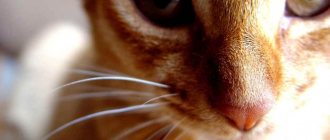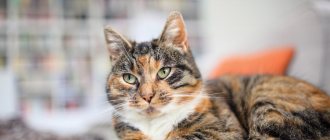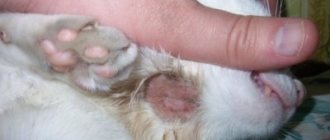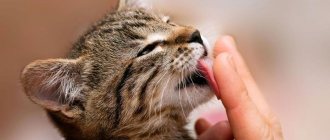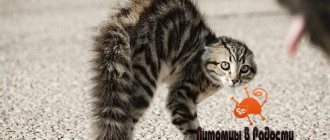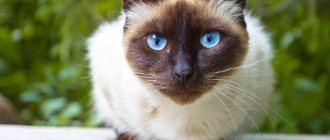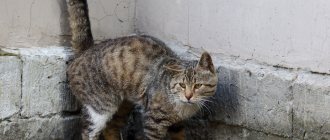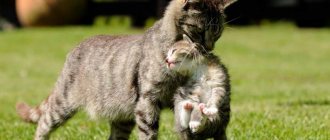Surely, each of us has come across such an amazing “phenomenon” as a cat’s purring - most often our four-legged animals purr when we stroke them (however, there are many other reasons underlying a cat’s purring).
Let's try to figure out in what cases our mustachioed friends make such unusual sounds, and how this affects us.
There is a huge amount of research being done on how cats purr. As a result, scientists noticed that cats most often make such sounds when they are happy: they have just eaten, are basking in the sun, or are being caressed by their owner...
An interesting fact is that some domestic cats purr when they are near a sick person. Previously, it was believed that in this way the cat showed its sympathy and support to its owner. However, scientists have found that the vibrations emitted by animals have a healing effect. Those. it is possible that in this way the four-legged animals are trying to heal their beloved owner.
There is a theory that the low-frequency vibrations (20~30 Hz, depending on the breed) emitted by a cat stimulate its brain to release a hormone that promotes pain relief and healing. This explains situations where a wounded cat (in pain) or a cat purring during childbirth.
In some cases, cats purr to attract the owner's attention. In this situation, the animal may be hungry or the pet may miss human affection.
It has been recorded that kittens can purr already at the age of 2 days - probably in this way, the babies tell their mother that everything is fine with them. They purr mainly either during or after feeding. And the purring of an adult cat, in turn, lets the kittens know that they are safe and can feel free.
It turns out that a cat’s purring can express a whole range of emotions: pleasure, fear, boredom, love for the owner.
There is another interesting theory put forward by Californian scientists. It says that purring is a result of the “cat lifestyle”: due to the fact that our lazy pets can sleep or bask on a pillow for 18 hours a day, this negatively affects the bones of animals, and purring helps strengthen stagnant joints and allows muscles to atrophy.
The mechanism of purring in cats
Zoologists studying the process of purring put forward three hypotheses regarding the mechanism of rumbling:
- Cats purr using false vocal cords;
- Rumbling occurs due to air vibrations in the sinuses;
- Rumbling occurs in the lungs when air is exhaled.
The vocal cord hypothesis suggests that when a cat opens its mouth, it makes a meow, and when its mouth is closed, air vibrates in the larynx and creates a purr.
Other experts believe that when a cat experiences positive emotions, its blood pressure increases. Due to this, vibration appears in the chest and is transmitted to the sinuses, resulting in purring.
Still others believe that the rumbling is generated by the vibration of the intercostal and diaphragmatic muscles during inhalation and exhalation. Which part of the feline brain is responsible for purring is still unknown.
Theory one: vocal cords
A cat's purring calms everyone around.
According to the latest data, it is the vocal cords that help the pet produce the sweet rumbling that has such a calming effect on everyone in the area. The process itself begins in the cerebral cortex as a result of the action of external stimuli (we will talk about them a little later), from where nerve impulses go down to the muscles of the larynx, causing them to vibrate, which is why purring occurs.
A similar theory states that the source of sound is the hyoid bones at the base of the skull, when they vibrate, a characteristic vibration appears.
Still others believe that the cat itself controls the vocal cords, contracting and relaxing the muscles of the larynx in a special way during inhalation and exhalation.
Cat emotions and rumbling
There are many emotional states that cause a cat to purr.
The most basic ones are:
- Gratitude. A small pet purrs with pleasure from affection, a treat received, or from being close to its owner.
- Relaxation before bed. When a cat feels safe, relaxingly dozes before bed in the sun or in the arms of its owner, it purrs with pleasure.
- Dialogue between a cat and kittens. The cat, approaching the kittens, purrs, calming them down. In the wild, kittens were often left alone while their parents hunted, and thus the adults warned them that there was nothing to be afraid of.
- Self-medication and treatment. If the cat is sick or one of the pets is sick, it stabilizes the metabolism and blood circulation process due to vibrations. At these moments it is better not to touch the animal.
- Hunting interest. A cat may make purring sounds when playing or watching “game.” This is how she shows her interest.
- Fear and aggression. Many people have watched cats purr before a fight. This is how cats express their dissatisfaction and readiness to attack.
In different situations and different emotional states of the pet, the rumbling has a different tone.
When communicating with other animals, a cat may purr quietly, which indicates its trust. If a cat purrs loudly when meeting other cats, then it shows a leadership position and a readiness to attack. Sometimes purring is a request for mercy if the animal understands that it is weaker than its opponent.
Which other member of the cat family can purr?
Once you understand how cats purr, it is not so difficult to understand which of their wild relatives is capable of emitting similar sound vibrations. Large cats differ not only in the shape of the hyoid bone, but also in the elasticity of the ligaments. Only the group of small cats has the most flexibility: cheetahs, ocelots and lynxes; they can make purring sounds.
Despite physiology, there are exceptions. Purring large predators include snow leopards, pumas, clouded leopards and leopards. Given the structure of the larynx, their ability is a real mystery.
Rumbling in communication with a person
Cat owners most often perceive purring as a sign of gratitude, but cats express a whole range of emotions with this sound. Let's figure out why cats purr.
- Cats are very sensitive to the emotional state of the owner. If the owner is tired, upset or depressed, the small pet will always try to lie down next to him or in his arms and begin to purr. It has been scientifically proven that the frequency of purring puts a person into a trance, akin to meditative practices, and he calms down.
- Often, purring is an expression of pleasure. When you pet your pet to show your love, your cat will begin to purr to show how much she likes it.
- Domestic cats are talented manipulators. When begging for a treat or affection, they may poke their heads into your hand, making a purring noise. Or rub against your legs.
- If, lying next to the owner, the cat stops purring and listens, it means that something has alerted the animal.
If your cat is constantly purring, you should pay attention to your pet's health. The animal may be sick or injured. The pet could have problems with the vocal cords, and the cat is simply not able to meow.
Owners who wonder why a cat purrs like a tractor may simply not notice that not everything is all right with the animal, and in this way it heals and calms itself.
An attentive owner will always notice oddities in the pet’s behavior.
Known Causes
Years of research have not given a clear answer to why cats purr. The lack of an answer against the backdrop of modern capabilities and technology means that cats are much more mysterious than we used to think about them. Summarizing the assumptions of scientists and the observations of owners, we can name the following reasons known to man for cats purring:
- Newborn kittens purr with food pleasure.
- A feeling of safety, satiety, well-being, and household contentment.
- Expression of tenderness, affection.
- Trying to subdue another cat or avoid a fight with it.
- The desire to lure another cat with you, for example, to play.
- Displaying pack position, such as when a cat rubs against furniture or your legs.
- The desire to communicate with the outside world.
- Expression of unpleasant experiences: fear, stress, pain, anxiety.
- Instinctive desire for physical health - purring is believed to make cats' wounds heal faster.
- Stimulation of immunity.
Many people believe that a pet purrs when it wants to talk. No matter how beautiful this version may sound, don’t delude yourself. The cat purrs even in your absence. However, it is also not worth underestimating the role of humans in the lives of cats, since the latter meow only to people. Yes, yes, cats do not use the standard “meow” when communicating between themselves and other animals.
Rumbling as a remedy
Scientific studies have confirmed that cat owners are less likely to suffer from nervous disorders, cardiovascular diseases, arthritis, arthrosis and respiratory diseases. In families where there are cats, children have higher immunity.
- The range of frequencies that a cat makes when purring stimulates the brain's defense mechanisms and has a beneficial effect on metabolism.
- Due to the heat that the cat transmits while lying on a sore spot and under the influence of vibration, blood circulation improves. Under the influence of low frequency vibrations, increased production of endorphins begins, which significantly reduces pain.
- Doctors have long noticed this feature, which is why they often recommend that older people get a cat. The patients themselves confirm that after contact with a purring cat they feel better, and medical examinations confirm this.
British scientists have even developed a new therapeutic method - cat therapy, which is successfully used all over the world.
Cats themselves have increased stamina because they can heal themselves by purring. Their wounds and injuries heal much faster than those of other animals, which gave rise to the saying that “a cat has nine lives.”
Interesting facts about rumbling
- Cats never meow when communicating with each other; they either purr or hiss;
- If you need your cat to stop purring, just turn on the water. The sound of flowing water will silence the animal.
- Kittens that do not yet have hearing purr while eating, expressing their pleasure;
- A cat's purring during sleep replaces its physical activity;
- Purring before bed helps both the cat and its owner fall asleep, as it drowns out the sounds of breathing and heartbeat.
Rumbling has many emotional connotations. Still, more often than not, pets purr with pleasure. When a cat is fed, caressed and healthy, it will gratefully please its owner with a loud purr.
